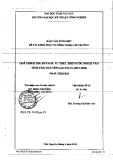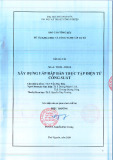
Schöchl et al. Critical Care 2010, 14:R55
http://ccforum.com/content/14/2/R55
Open Access
RESEARCH
BioMed Central
© 2010 Schöchl et al; licensee BioMed Central Ltd. This is an Open Access article distributed under the terms of the Creative Commons
Attribution License (http://creativecommons.org/licenses/by/2.0), which permits unrestricted use, distribution, and reproduction in
any medium, provided the original work is properly cited.
Research
Goal-directed coagulation management of major
trauma patients using thromboelastometry
(ROTEM
®
)-guided administration of fibrinogen
concentrate and prothrombin complex
concentrate
Herbert Schöchl
1,2
, Ulrike Nienaber
3
, Georg Hofer
1
, Wolfgang Voelckel
1
, Csilla Jambor
4
, Gisela Scharbert
5
,
Sibylle Kozek-Langenecker
5
and Cristina Solomon*
6
Abstract
Introduction: The appropriate strategy for trauma-induced coagulopathy management is under debate. We report
the treatment of major trauma using mainly coagulation factor concentrates.
Methods: This retrospective analysis included trauma patients who received ≥ 5 units of red blood cell concentrate
within 24 hours. Coagulation management was guided by thromboelastometry (ROTEM®). Fibrinogen concentrate was
given as first-line haemostatic therapy when maximum clot firmness (MCF) measured by FibTEM (fibrin-based test) was
<10 mm. Prothrombin complex concentrate (PCC) was given in case of recent coumarin intake or clotting time
measured by extrinsic activation test (EXTEM) >1.5 times normal. Lack of improvement in EXTEM MCF after fibrinogen
concentrate administration was an indication for platelet concentrate. The observed mortality was compared with the
mortality predicted by the trauma injury severity score (TRISS) and by the revised injury severity classification (RISC)
score.
Results: Of 131 patients included, 128 received fibrinogen concentrate as first-line therapy, 98 additionally received
PCC, while 3 patients with recent coumarin intake received only PCC. Twelve patients received FFP and 29 received
platelet concentrate. The observed mortality was 24.4%, lower than the TRISS mortality of 33.7% (P = 0.032) and the
RISC mortality of 28.7% (P > 0.05). After excluding 17 patients with traumatic brain injury, the difference in mortality was
14% observed versus 27.8% predicted by TRISS (P = 0.0018) and 24.3% predicted by RISC (P = 0.014).
Conclusions: ROTEM®-guided haemostatic therapy, with fibrinogen concentrate as first-line haemostatic therapy and
additional PCC, was goal-directed and fast. A favourable survival rate was observed. Prospective, randomized trials to
investigate this therapeutic alternative further appear warranted.
Introduction
Coagulopathy has been shown to be present in approxi-
mately 25 to 35% of all trauma patients on admission to
the emergency room (ER) [1,2]. This represents a serious
problem for major trauma patients and accounts for 40%
of all trauma-related deaths [3]. Coagulopathy forces a
strategy of early and rapid haemostatic treatment to pre-
vent exsanguination. Fresh frozen plasma (FFP) is part of
the massive transfusion protocols in most trauma centres
[3-5], although its efficacy is uncertain. Massive transfu-
sion protocols that favour a red blood cell (RBC):FFP
ratio of 1:1 have shown conflicting results [6-14]. In addi-
tion, there are well-recognised risks associated with FFP
administration in the trauma setting, such as acute lung
injury, volume overload, and nosocomial infection
[12,15-17]. According to the Serious Hazards of Transfu-
* Correspondence: solomon.cristina@googlemail.com
6 Department of Anaesthesiology and Intensive Care, Salzburger
Landeskliniken SALK, 48 Müllner Hauptstrasse, 5020 Salzburg, Austria
Full list of author information is available at the end of the article






























